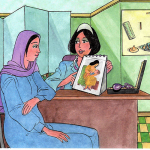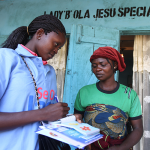Your analysis in Step 1 identified potential priority groups. In Step 2, you will divide and organize these groups into audiences who have similar needs, preferences and characteristics. This is called segmenting the audience. Segmenting the audience determines the specific audiences on which to focus. This allows you to develop and implement activities that are the most effective and appropriate for each of your specific audiences, focusing on customized messages and materials that best suit these various groups.
In this Step, you will complete three tasks to determine your primary audience and your influencing audiences.
While identifying potential priority groups in Step 1, you may have discovered segments within these groups who have similar communication needs and/or who are relatively homogeneous, meaning they have similar characteristics that are unique to their group and are different from other segments and the population in general. With unique communication needs and characteristics, these groups will need a specific approach to meet their needs and motivate change. These groups will be the potential audiences for your SBCC program.
What You Need to Know to Get Started
Situation Analysis Document: Provide copies of the Situation Analysis document from Step 1 to all relevant stakeholders who will be involved in the strategy development process. The Situation Analysis will serve as the foundation for all subsequent work. Step 2 builds upon the work done during Step 1 Task 6, “Identify potential priority groups.”
If stakeholders were not involved in the previous analysis tasks, there may be a need to present the Situation Analysis and get reactions and feedback if continuing from this point with a group. This will help ensure stakeholders are on board with decisions made in previous tasks and will allow you to move forward with Step 2.
Primary Audience: The Primary Audience is the group of people you want to reach with your messages. This may be the people who are directly affected by the challenge or who are most at risk for the challenge. Or it may be the people who are best able to address the challenge or who can make decisions on behalf of those affected, e.g. caregivers of young children.
Influencing Audiences: People who influence the primary audience, either directly or indirectly. Influencing audiences can include family members and people in the community such as service providers, community leaders, and teachers but can also include people who shape social norms, influence policies, or influence how people think about the challenge.
Process: Facilitated discussion
Output: Potential Audience Segmentation Table
- List potential primary audiences from Step 1 Task 6:
- What groups are directly affected by the challenge?
- What groups are most at risk for the challenge?
- What groups make decisions or have influence on those affected? (e.g. parents of children)
- List potential influencing audiences from Step 1 Task 6:
- What groups directly influence the primary audience?
- What groups indirectly influence the primary audience?
- List the potential audiences in the first column of the Potential Audience Segmentation Table.
- Identify possible segments by characteristics for each audience:
- Demographic – List information such as age, gender, marital status, educational attainment, and number of children.
- Geographic – List information on where the group lives. What region? Urban or rural? Is this an area of conflict or a peaceful area?
- Socio-Cultural – List information on the group’s language, culture, religion, ethnicity, and place in society.
- Behavioral – List the behaviors for each audience that affect or impact the challenge.
- Psychographic – List the attributes that are related to personality, values, attitudes, interests, and lifestyles.
- Ideational – List the ideational factors that may either hinder or facilitate social and behavior change. (Refer back to Step 1 Task 6 for explanation of ideational factors.) These characteristics may include knowledge of the challenge, beliefs and values, perceived risk, self-efficacy to change behavior, social influence, social support, and environmental supports and constraints. Refer to the description of Ideation for ideas on what to include.
Potential Audience Segmentation Table
| Potential Audiences | Potential Primary Audiences |
Potential Influencing Audiences |
|---|---|---|
| Demographic Characteristics | ||
| Geographic Characteristics | ||
| Socio-Cultural Characteristics | ||
| Behavioral Characteristics | ||
| Psychographic Characteristics | ||
| Ideational Characteristics | ||
Process: Facilitated discussion, ranking of potential audience segments
Output: Priority Audience Segments Table
To prioritize audience segments and decide which audience segments on which to focus first, consider the following:
- Re-visit the ideational factors and other details from Step 1 to help make a decision on what group(s) to address.
- Consider a phased approach by focusing on certain audiences in a first phase and adding other audiences in subsequent phases. This phased approach can start by addressing the audiences that are the easiest to reach and most receptive to change.
- Consider how best to use your resources and on whom to focus. If resources are limited, you may need to focus on fewer segments and on segments with potentially greater impact.
- From these considerations, answer the questions in the Priority Audience Segments table to help prioritize audience segments. Use a scale of 1 to 5 to answer the questions, with 5 being the most important to 1 being the least.
Priority Audience Segments
| Potential Segment | ||
|---|---|---|
| How many people in this group? (E.g. % of population in intended areas of operation) |
||
| Is addressing this group crucial to achieving program objectives? 5 Most crucial 1 Least crucial |
||
| Is the group most affected/at risk? 5 Most at risk/affected 1 Least at risk/affected |
||
| How likely will this group change within the timeframe of the SBCC program? 5 Most likely 1 Least likely |
||
| Does the SBCC program have the resources to focus on this group? 5 Sufficient resources 1 Insufficient resources |
||
| Rank(total from previous boxes) | ||
| Determine which group(s) to focus on and during which phase, according to rank |
Download this chart as a Word document.
Based on your answers from the worksheet above, consider the following questions:
- Is it necessary that you include this group as an audience?
- Will focusing only on this group be enough to achieve your program goals? If not, what other groups need to be involved?
From this analysis, specify the groups on which you will focus your SBCC program. Determine which audiences will be reached in phase one and which groups can be reached in subsequent phases of the program.
Prioritizing Audience Segments Example
Here's how Egypt's Communication for Healthy Living project prioritized its audience segments.
Process: Facilitated discussion and writing
Output: Audience Profiles
- Develop an audience profile for each audience segment to help personalize each audience and bring the audience to life.
- Create a profile that embodies the characteristics of the specific audience. Use qualitative and quantitative data to draw up this profile. Focus the profile on telling the story of an individual within the group who can represent the intended audience. You may want to name this individual or choose a photo that represents this person to help you better visualize who this person is and tell his or her story. The profile should include details on current behaviors, motivation, emotions, values, and attitudes as well as socio-demographic information which could include age, income level, religion, sex, and place of residence. During the development of messages and materials, you can focus on this individual rather than on a collection of statistics or a mass of anonymous people.
Developing Audience Profiles Example
See examples of audience profiles developed by Nigeria's NURHI project and a safe water project in Indonesia.
Final Outputs for Step 2
Segmented and prioritized audiences
- Primary audience
- Influencing audiences
Audience profiles
- Primary audience
- Influencing audiences




No Comments